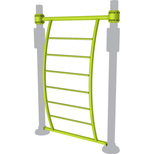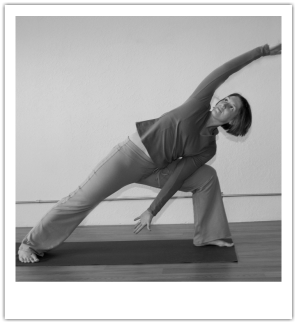|
This week I am in Barcelona, Spain competing in Life Fitness' Global Personal Trainers to Watch competition. Since I am in the learning phase of my yoga training, yoga is always on my brain. Being in Spain made no difference. Thus, in the wee hours of the morning, jet-legged and all, I was up writing a yoga sequence that I could do on the Life Fitness Synrgy BlueSky. Here is what I came up with! Monkey Bar (Long) Dip/Leg Raise StationArc LadderTraverse Bar (Long)
Step Station
Cargo Net (Long)
Row Station Press Station Pull-Up (Short)
Ab Station
Having a chance to "play" on a new piece of equipment is always fun for me. This event was an experience of a lifetime and my yoga teacher in training came along for the ride too! LW
0 Comments
In my early days of yoga practice, I have to admit that I was a bit of a props snob. Maybe because of my age or maybe because my body let me do pretty much whatever I wanted, I thought props were for the weak. But within the last five or more years of practice I have gained great respect for all yoga props. As my body morphs into the curvy, anterior ball shape of pregnancy, the use of blocks has been essential to my practice. The two most common types of blocks available are unique and each have there own purpose. Harder wood or foam blocks act more like support as opposed to the softer rectangular foam variety that provide cushion and give. These are my modifications to practice this week using my foam rectangular blocks (still needing to buy wooden blocks for home!): Easy Pose (Sukhasana) & Revolved Head to Knee Pose (Parivrtta Janu Sirsana) As I've stated before, I love sitting on the ground. Yet, to give some relief to my low back, I do like to sit on my block(s). By raising the hips slightly, it causes less tension in the hamstrings and low back. These two poses were much easier with ease in my back! Triangle Pose (Trikonasan) & Extended Side Angle Pose (Utthita Parsvakonasana) Since my body isn't able to twist as easily these days nor bend over as far, I used my block to give some height to the pose. Placing my hand on the flat block, allowed the asana to be less strained than if I tried to reach for the ground. Not here to make leaps in my yoga practice, just wanting to maintain! Deep Squat/Garland Pose (Malasana) Interestingly, it is a day to day variation as to whether or not I can place my feet flat on the floor in deep squat. So on those days I can't, my best option is to place the blocks under each foot so that my heels have something to rest on. The blocks allow me to feel more grounded in a position that can be very tricky to hold and balance! Hero Pose (Virasana) It is nice to have variations for sitting poses. In about 1/8 of my practice do I actually sit in a kneeling position so it is a welcomed change of position. In this pose, I sat on two blocks to minimize the strain on my legs and quite frankly, allow space for the baby! So, who knew that I'd love my yoga blocks so much. When I bought them for home, I was thinking they'd just gather dust. Now, they are a mainstay of my prenatal yoga! Blessed to have my blocks, LW 34 weeks pregnant!
Extended side angle pose (Utthita Parsvakonasana), to me, is a foundational pose but receives little attention compared to its sister Warrior poses. Officially, not a warrior pose it has the markings of one (such as the bent knee like in warrior II) except for the side bending. It was an enlightening pose this week, which follows the past two weeks' pattern of bending (forward and side). To be honest, I had a major release (physical and emotionally) with extended side angle pose this week and I don't totally get why. Was it from the hips? Apparently, releasing the hips can be an emotional experience but I have no reference or source to date. Is it the place of tension that rarely gets a break? Probably. Especially as a pregnant women. Yes! I really like this pose for my pregnant body. It focuses on single leg strength and opening of the side body among opening the hips. One of the things I want to maintain is my leg strength. After sitting for many months nursing with my first child, my legs atrophied to a point where my pants were hanging off me. Muscle tone and strength were gone. So, continually working on leg strength now and once baby arrives is key for me. Also, in the past couple weeks I've been stretched (read: my belly has popped). And the sensation it brings is very bizarre. It's like the pressure of the abdominal cavity is increasing and my skins elasticity is not ready for the stretch. So a dull ache. Extended side angle pose is fantastic for stretching the areas of my torso that have been under such pressure. *sigh* Note: That's not me…yet. Nor have I ever seen something like this before!
Forward bends last week, side bends this week. The more I explore yogic bends, I realize there is much more to them than meets the eye. Side bending, as one would expect, is to stretch the lateral sides of the body. The side abdominals (obliques) and rib musculature (intercostal muscles) receive a nice lengthening with bending to the side. However, depending on the exact positioning, certain anatomical parts are moving and others are fixed and this will dictate what actually is happening. In Coulter's book, Anatomy of Hatha Yoga, he outlines the differences explaining the role of the spine and the pelvis. For example, this week I practiced a standing side bend with my feet together. The movement is initiated by the torso and is a lateral flexion of the spine. Try it - you barely move laterally to the side. Yet, if I simply changed the position of my feet to a shoulder width stance, my pelvis and hips would also be a part of the movement. As I lean to the right, my right hip will drop and I will not only be doing a side bend but also a slight twist and forward bend. Interesting! At least from my anatomy and biomechanic loving self! This or that? With every post, I am also striving to determine the Sanskirt name for the poses I explore. Well, this one took some effort to figure out.
I've frequently heard this pose called half moon (Ardha Chandrasana) but as I enter this into google images, it shows me multiple poses (as above). Wait a minute! There must be more to this as well. It turns out that the side bending pose of half moon in Hatha yoga is the foundation of the half moon pose in Bikram yoga; Hatha yoga is the ancient practice versus Bikram is the more modern practice and Bikram derives many if it's 26 poses from the original Hatha yoga. The reason the pose was modified, is due to the fact Bikram is a much faster paced practice and the original half moon pose would not have fit in a more fluid, quick paced practice. So, I was partly right in calling it half moon pose but I didn't realize it was the name of two poses. I suppose as in English where an orange is a food and a colour, Sanskirt can also have the same name for two things too. To further explain my questioning of naming, in Schiffmann's book, Yoga: The Spirit and Practice of Moving into Stillness, he explains there is Ardha Chandrasana I (standing side bend, what I did this week) and Ardha Chandrasana II (half moon pose) and both can be done in practice. I've barely scratched the surface of side bends it seems. And as I look through multiple books and websites, as I said, there is more than meets the eye with side bends. More bending to come…at many angles! LW |
Aspiring Yoga TeacherI've practiced yoga since I was a pre-teen and have always found it to keep me centered. I will be a teacher one day and this is my journey to discover teaching and practice. Archives
April 2019
Categories
All
|
Edmonton, Alberta















 RSS Feed
RSS Feed